Table of Contents[Hide][Show]
How to make homemade ghee on the stovetop quickly and easily for a healthy cooking fat that is shelf stable and nourishing.
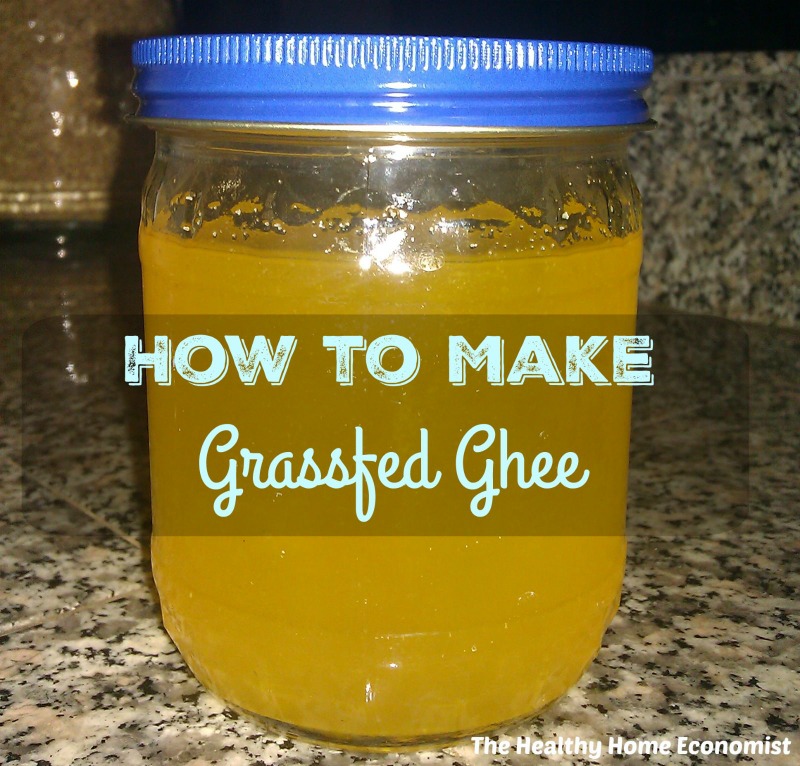
Knowing how to make ghee is simply a must for any Traditional Cook. Clarified butter as it is also known, has been used for thousands of years by Indian cultures. In fact, traces of ghee have been found on fragments of Indian pottery dating as far back as 6500 BC!
When in a liquid state and made from unheated butter, ghee is called butter oil. Dr. Weston A. Price discovered that butter oil and cod liver oil work synergistically to supercharge absorption of Vitamins A, D, and K2 known as the X-factor.
Dr. Price always carried flasks of cod liver oil and butter oil to the bedside of very ill patients. More often than not, he was able to revive them with a few drops of each under the tongue. Using cod liver oil or butter oil separately did not have the same deathbed reviving effects.
Benefits of Ghee over Other Cooking Fats
It is best to know how to make clarified butter oil or ghee yourself rather than buying from the store. Notice the picture above of a jar that I made myself with pastured butter from a local farm. It is so yellow!
Commercial ghee from the store is a pale yellow, indicating lower nutritional value from cows eating grain mix instead of fresh green grass.
Ghee from the store is also ridiculously expensive, so learning to make it yourself is not only a more nutritious way to go, it is very cost-effective.
I make clarified butter oil for about half the cost of what it would be to buy it at the health food store.
Unlike butter, ghee does not need refrigeration and keeps well on the counter or pantry for many months. Keeping a jar in the pantry for a quick veggie saute is very convenient!
Another benefit of ghee is that it is easier to digest as all the milk solids (proteins) have been removed from the butter. Very frequently, even those with a true dairy allergy find that ghee presents no trouble for them.
Another advantage to using clarified butter instead of plain grass-fed butter is that the grassy taste and sometimes cheesy smell of the butter is eliminated.
Therefore, by learning to make clarified butter oil from grass-fed butter, you will find that you now have a healthy fat for cooking that does not displease your family with a cheesy odor. This can sometimes happen with grass-fed butter alone.
Homemade Grass-Fed Ghee
The recipe and video lesson below covers how to make this healthy and indispensable fat for use in your own kitchen.
I also cover how to make clarified butter capsules. This is a convenient way to take butter oil with your daily dose of cod liver oil.
If you are spending money on high vitamin cod liver oil (this is the brand I’ve used since 2015) it is a must to be taking it with clarified butter oil. This supercharges the beneficial effects!
Note that it is not advisable to make ghee from homemade raw butter. The heating process causes a loss of the enzyme and probiotics in this special food.
Prefer to Buy?
If after reviewing the recipe and video demo below you decide to buy instead, I would recommend this vetted source as a premier retailer of quality grass-fed ghee. Plain, cultured, and herb-flavored varieties are all available including a coconut oil/ghee blend.
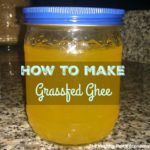
How to Make Ghee
This simple recipe for making ghee can be accomplished on the stovetop in just a few minutes.
Ingredients
- 1 lb butter preferably grassfed and organic
- 1 wide mouthed mason jar quart size
- 1 cheesecloth fine mesh
- 1 funnel
Instructions
-
Place pound of butter in a medium sized pot or stove safe glass bowl. Turn heat on low and allow the butter to gently liquefy.
-
Turn heat to medium-low and gently remove foam that comes to the top of the melted butter with a slotted spoon.
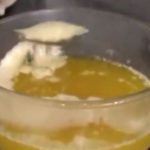
-
After removing the foam, allow the melted butter to simmer on medium-low heat for 5-10 minutes longer to allow all the milk solids to settle out on the bottom of the bowl. You will know when the separation process is complete as the solids will be slightly brown on the bottom and the clarified butter will be completely clear and transparent.
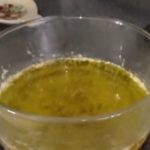
-
Line a funnel placed into the open end of a wide mouthed mason jar with a fine mesh cheesecloth.
-
Pour the clarified butter into the funnel so that it is strained through the cheesecloth as it enters the mason jar.
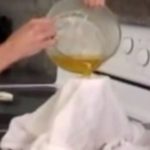
-
Allow the finished ghee to cool in the mason jar. When room temperature, fasten the lid on tightly and store in the pantry as a convenient and incredibly healthy cooking oil for all your kitchen needs.








Hello, I found a “pastured cows” organic butter at Albertson’s Market in California, the brand is Wild Harvest organic… This is pasteurized butter. They add lactic acid to the cream. I called the company with questions and they called me back today. The cows that this butter comes from are in the Mid West (sometimes they truck in cream from the East Coast also). Because of snow they also feed dried grasses in winter, and when the cows are being milked twice a day they are given grains at each milking- grains can include corn, flax, wheat, etc and also can include from 0-10% soy, all organic of course. Also, the farmers can decide how much grain to feed and what would be in it, as long as it is organic. The farmers who join the co-op are not permitted to sell raw milk, the contract states that the farmers must sell all milk to the group. What do you think of this description of this pastured cows butter? Also, please see my previous post regarding Ziyad brand Butter Ghee. Thank you for so much helpful information!!
Hi Sarah,
I was in my favorite Mediterranean/Middle Eastern market and found a butter ghee called Ziyad Brand All Natural Butter Ghee. The ingredients are clarified butter oil. It is in a glass jar and the color is bright bright yellow, like a smiley face. When I opened it it smells exactly like the grass fed raw butter from Organic Pastures! Do you have any knowledge of this brand? thank you!
Hi Sarah,
I watched another video about making Ghee and that guy’s saves all of “foam” to be used much like you would normally use butter. After making my first batch of Ghee, I gave it (the foam) a taste and it was actually pretty good. After adding a bit of salt, it was quite good.
Anyway, as long as the flavor is pleasant, do you know of any reason NOT to use it? Like, is it bad for you?
Thanks…
NOT ONLY IS THAT FOAM STILL BUTTER THAT CAN BE EATEN AND USED IN COOKING, IT CAN ALSO BE RENDERED IN WITH OTHER FATS WHEN MAKING LYE SOAP!
We live on a small homestead and milk two Jersey cows. I have tons of raw milk butter I made last year to have in the freezer while our cows were dry during the winter. Can I use this butter, some of which has been frozen for nearly a year, to make my ghee? I made so much and now it’s time to make it again, so I’d love to use last year’s for my ghee.
I was wishing Sarah would come back and answer your question RobinP, as I have the same query. I have several pounds of homemade butter in the freezer from batches I’ve made over the winter months. It’s not totally from grassfed, of course, but a lot of it is.
The last time I purchased KerryGold butter it was waaaaay salty. I have been told never to use salted butter to make ghee, is that true? I’m wondering why it would, or wouldn’t, make any difference? I would think the salt would give it a longer shelf life, but the KerryGold was so salty that I think you’d get an off taste.
Suggestions? Ideas?
I found this information about ghee. Don’t know how accurate it is though because she claims ghee will only keep for about 1 month. Mine never lasts that long when I finally DO get a good batch, but I think it usually keeps longer than a month, right?
===================
Here’s the article:
“How to Make Ghee at Home
To make ghee, add one pound of unsalted (preferably organic, although that can be pricey) butter to a large, heavy pot. Bring the butter to a boil, being careful not to scorch or burn the ghee, as that can irreparably damage the flavor. This takes about three minutes. Once the ghee is boiling, lower the heat to medium and continue boiling. A foam of milk solids will develop on top of the ghee, and eventually settle to the bottom of the pot. The ghee is done once it has stopped foaming, is a translucent dark golden color, and when there are visible brown milk solids on the bottom of the pot- this takes about seven minutes. Remove the ghee from the heat, and pour it into a heatproof container, through a fine sieve or mesh strainer to remove any further milk solids and impurities. Ghee does not need to be refrigerated, and can keep for up to one month on the shelf.”
Taken from this site:
Then there’s another guy (at the same site) who insists that salt should be used (see why this is so confusing?? Everyone has their own beliefs. Food is now a religion!)
Well, I’m now back to asking the same question about salt. Grrrrrr . . .
SINCE SHE NEVER CAME BACK TO ANSWER YOUR QUESTION, I FEEL FREE TO DO SO: YES, YOU CAN USE THE BUTTER TO MAKE INTO YOUR GHEE! THERE’S NO REASON WHY NOT! BY REMOVING THE SOLIDS AND FOAM FROM THE BUTTER IN THE HEATING PROCESS, YOU ARE REMOVING ANYTHING THAT WOULD MAKE IT TURN BAD ANYWAY. YOU JUST HAVE TO MAKE SURE YOU POUR THE STRAINED GHEE OIL INTO A CLEAN, [STERILE WOULD BE BETTER] DRY JAR WITH A STERILE LID TO START WITH. YOU CAN STERILIZE THE LID AND JAR IN BOILING TEMPERATURE WATER FOR A FEW MINUTES, USE TONGS TO REMOVE AND STAND ON A CLEAN TOWEL TO DRAIN DRY AND COOL DOWN BEFORE ADDING THE STRAINED GHEE OIL. I HOPE THIS HELPS YOU!
Say, Sarah, was that a Pyrex bowl you were using to clarify the ghee?
Yes it was.
I have a question about leaving it out on the counter. I was talking with someone yesterday who said they made ghee (learned how in a class on Indian cooking) and her ghee got mold in it after a short time. Is that normal? Why would that happen? TIA
Not sure Carol. I live in hot, humid FL and mine lasts fine in the pantry for several months. Of course, refrigerate it if you have a concern. It just hardens up that way and is a little inconvenient for cooking.
Hi Sarah,
Thank you again for this elegant video and method to make ghee! Is there a brand of butter you would recommend if we can’d find local grass-fed butter? Also, should the milk solids be discarded or can they be recycled into another recipe?
Ranjani.
I think you should discard the milk solids Ranjani. If you can find local grassfed butter, Kerry Gold would be the best US brand. Not sure where you live, but just find the best quality most YELLOW brand you can find at the store. It will likely be a gourmet butter of some kind.
Thanks. I will, but spring is not quite here yet up north. And my farmer doesn’t sell butter in the winter. Soon…. spring will come… 🙂
At this time I can’t get any butter from my farmer so I’ve been using Kerry Gold and Pastureland. Are these butters both ok then for making ghee?
Thanks.
Hi Carol, yes those butters are fine for making ghee. Get some local grassfed butter when you have the opportunity, though.